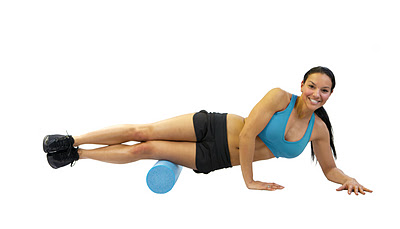There has been much written recently about the virtues of foam rolling. Is it really all that good for you, and why? Or maybe it's not all it's cracked up to be?
It can all be a bit confusing depending on what you read, and I have a had a lot of feedback about just that. I'll try to cut through the technical jargon and cut to the chase.
Foam roller for ITB
Every runner seems to be using a foam roller as part of their recovery these days, and it is considered along with the spikey massage ball an essential part of a runner's kit.
I believe this is for good reason too, but more about my thoughts later. Let's look at some recent articles to see what's out there.
Too much rolling on the ITB? This article's headline, " Your IT Band is Not the Enemy, (But maybe your foam roller is?)"
I received a lot of queries after this one, as to whether we should be rolling out our ITB any more. A closer look at the article tells us not that, but that underlying many ITB issues is a glut medius (GM) weakness that also should be addressed.
Your ITB can be placed under excessive stress as a result of glute medius weakness, that results in destabilising the pelvis & hips during the stance phase of the gait cycle. Basically if your GM is weak, your hips & pelvis may not remain level as you push off the ground with your opposite leg ( propulsion).
Running form, and hip/pelvis stability. Are they level?
Furthermore, if your glutes aren't activated early in this phase of the gait cycle, more load and strain will be placed on the ITB, and quads potentially leading to overload and strain, then injury. This article provides some valuable information about testing & strengthening your GM. But don't forget to incorporate this activation into the early downward phase of your gait cycle - as the foot comes down into the stance phase. Strong glue activation leads the propulsion phase, thus taking the load away from the quads, ITB and hence knee! (Apologies for getting technical)
Technique is everything to the runner!
The next article is a very good Review of Literature on Foam Rolling.
In summary, and to keep it very simple; These studies have shown that foam rolling may;
1. Decrease exercise related muscle fatigue,
2. Improved vertical jump height and maximal force production (power),
3. Improves range of motion ( particularly across the knee),
4. Reduces muscle soreness & fatigue
All in all, there is evidence to strongly suggest that foam rolling aids in exercise recovery & (thus) helps prevent injury.
For those runners like myself, most of us would agree to this and foam rolling remains a critical part of our regular recovery routine.
Why & How?
Muscles get tight & sore after heavy exercise, as part of the effects of overload in training, which results in positive physiologic adaptations such as strength & conditioning.
Recovery however occurs when we are not training, and between sessions. What we do during this time determines how well recovered we are for our next training session and so on. If we are not well recovered, and continue training, invariably and inevitably tissue breakdown occurs, leading to injury.
Sadly, many runners spend much of their recovery time sitting, usually at work through the day, and then at home in the couch during the evening. This results in our muscles and their protective fascia becoming shortened & thickened, thus creating stiffness & soreness. If this is not addressed, the cumulative effect can lead to build up of tension, loss of elasticity in the muscle, reduced blood flow & muscle function and then injury.
Using your foam roller regularly can effectively address this as we have seen, and hence assist recovery, and help prevent injury.
The key is to roll regularly, particularly at the end of the day after much sitting to assist recovery overnight. You can roll before exercise and/or after.
Tip: keep your foam roller in front of the couch to remind you not to sit in the couch, but to get on the floor & roll instead!
Your goal with rolling, is basically to seek out & roll out the tight & sore bits (hard, inflexible knots), until they change into softer, springy & elastic tissue. This usually only takes between 30-90 seconds on each tight bit. Then stretch out the muscle for 20 seconds or so, then move on to another tight bit, and so on. You will soon learn where your tight or problem bits are and with regular practise how to manage them.
You don't need to do it too much, or for too long, just regularly.
Good runners are strong and springy! This is what will help you to Run Well; strong, elastic tissues ( muscle & fascia).
Keep rolling, and once again, as always Run Well!



